Return of the Cicadas is a documentary about the return of the Brood X periodical cicadas, by producer Samuel Orr. It is worth watching for for folks in the Brood II area so they know what to expect.
Take a look:
Magicicada periodical cicada Broods.
Return of the Cicadas is a documentary about the return of the Brood X periodical cicadas, by producer Samuel Orr. It is worth watching for for folks in the Brood II area so they know what to expect.
Take a look:
Yesterday I visited my family’s house in Metuchen, New Jersey. I looked in the backyard and found loads of cicada holes — a hole every 6″ to 12″. I was also clear that animals, like squirrels and raccoons, had been digging at many of the holes. Today I got a spade and gently dug around one of the holes. About 3″ down I found a Magicicada cassini nymph, about 1 inch in length, legs wiggling slowly, red eyes.
Here’s the hole:

Here is the nymph:

It’s clear that the cicadas are ready to emerge, and are just waiting for the temperatures to get a little warmer (to warm their bodies to around 64 degrees F/18º C). Today reached 72 degrees F. It will reach 77 F on Friday, and some will likely emerge. Saturday temperatures will be back down to 39 F. These cicadas will likely be confused for a little while.
More holes, many of which were widened by predators looking for a cicada snack!
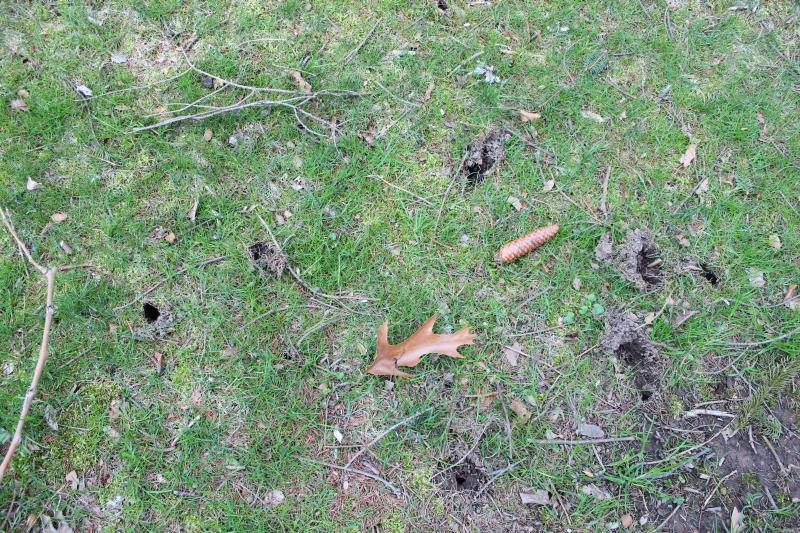
Also visit: updates on the emergence.
Gene Kritsky is one of the leading periodical cicada researchers. He’s asked that we help with his research regarding temperature and cicada emergence. He needs to know the date that cicadas first emerge, and then the date when they appear in large numbers in a given locality. To contact Gene with your findings, email him at cdarwin@aol.com.
Here are the details:
I wanted to alert you to a paper that I published with Roy after Brood XIV. I had placed sensors at cicada depths in Roy’s backyard, and also hung others in the area trees. We recorded the temperatures at 10 minute intervals at all the locations. I was trying to find a weather model to predict soil temperatures without using probes. This would be cheaper for people wanting to monitor an impending emergence. This research is based on what potato farmers do to track the growth of their crop.
We found that the average of the running three day and two day mean temperatures was a good predictor of soil temps.
The formula along with the extended forecast can be used to forecast soil temperatures. Once we get the 64º F soil temps and a nice rain we got emergences. I am hoping to test this model again this year, which in part is why I emailing you. What I need to know is the date that cicadas first emerge, and then the date when they appear in large numbers in a given locality. I will then use weather data to check the soil model. Can you ask readers to send me that info? Many thanks.
You can find more details on the model at:
http://inside.msj.edu/academics/faculty/kritskg/cicada/Site/Estimating_soil_temperature.html
An easier way of getting to the details is to go to www.msj.edu/cicada and click on estimating soil temperatures. That site will also link them to John’s mapping page, activities for kids, etc.
Thank you for your help.
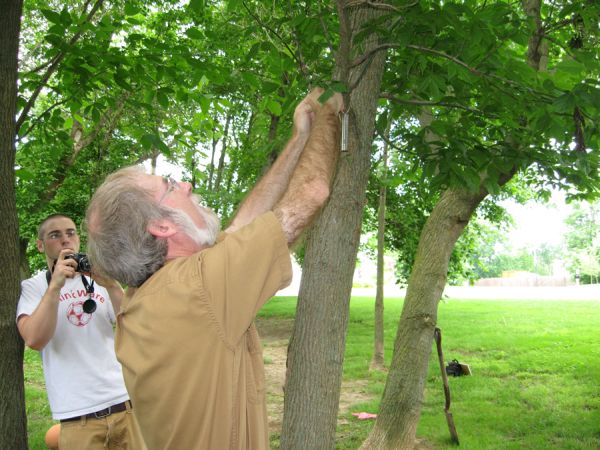
More info about Gene Kritsky:
My Goals and Objectives for the Brood II Emergence:

Chances are you might see me during the emergence. I’m told I look like “Lucius Malfoy”.
John Cooley of Cicadas @ UCONN (formerly Magicicada.org) kindly provided us with an updated version of the Brood II map. The old map was circa 1907. Click the image below for a BIG version:
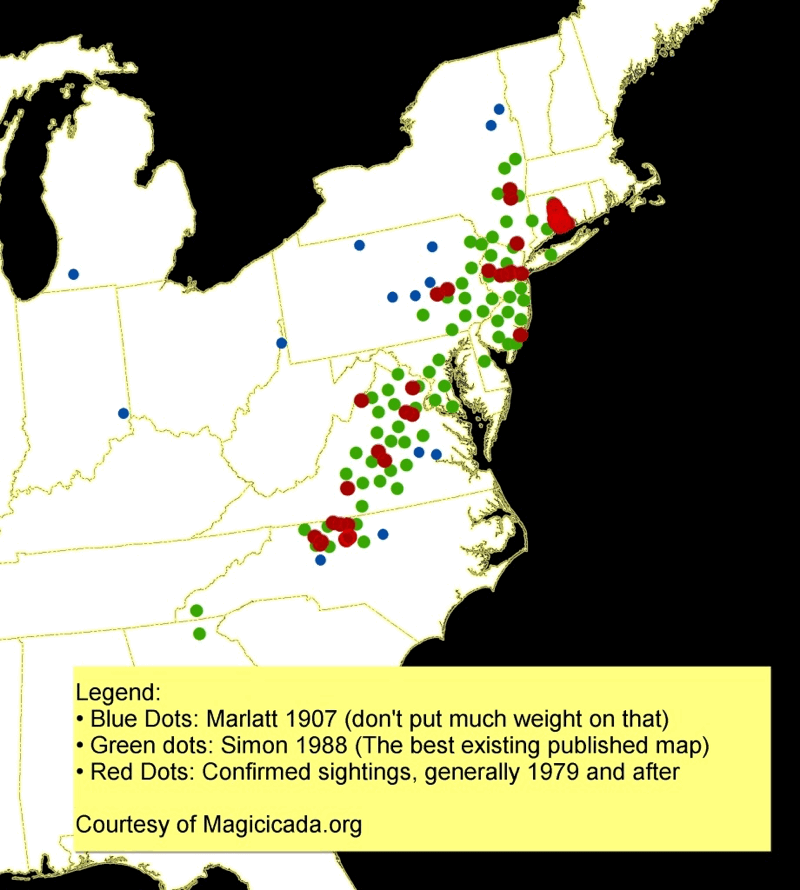
Are you preparing for the 2013 invasion of the Brood II Magicicada? If so, what type of cicada prepper are you?
If you’re visiting Cicada Mania, you’re probably trying to figure out when and where the Brood II cicadas will emerge. We have a page for that.
Once the cicadas arrive you’re also going to report them to Cicadas @ UCONN (formerly Magicicada.org), right? You’re also going to upload your photos and video to Facebook, Flickr, Twitter, YouTube, Vimeo, Pinterest, and Instagram, right? You’re going to tag your photos & video with appropriate tags like #BroodII, #Magicicada, and #17YearCicada as well.

Kids will probably enjoy a cicada emergence more than any one group of people. Kids will want to learn, capture, collect, observe, photograph, draw, and write about cicadas.
If you want to learn about cicadas, there are many cicada websites, including Cicada Mania. There are also many books to read; ask your local library to obtain a few of them.
Capturing periodical cicadas is easy. Unlike other insects, these cicadas are slow and easy to grab when they’re on the ground on low on a tree. You can use a butterfly net if you want to catch one in flight. At night, when they first emerge, they are especially easy to catch. You can use a flashlight to spot them coming out of the ground, and shedding their skins on tree branches.
A portable butterfly pavilion is a great place to temporarily keep and observe cicadas. It’s a lot better than a coffee can with holes punched in the lid. Another good option is to use an old aquarium and turn it into a terrarium filled with natural objects, like tree branches. You can also wrap a tree branch with netting and place the cicadas inside that, and observe then in their natural habitat.
It’s good to have a magnifying glass or a camera with a zoom feature so you can observe the cicadas up close. If you have a camera, make sure you take plenty of photos and videos so you have something to remember about the cicadas.
Preparation list:
Do you consider yourself a citizen scientist or amateur cicada researcher?
Prior to the emergence cicada researchers will monitor the temperature of the soil, using a ground thermometer, or a cicada tracker. They will also monitor the ground for dime-sized holes and cicada chimneys.
Each night the cicada researcher will check the ground at the foot of trees, waiting for the first emerging nymphs.
Once the nymphs start to emerge, the cicada researcher will record the location, take photos, video, and take notes on the number of cicadas observed. The researcher will also likely keep some samples of the cicada population.
After about a week, the male cicadas will be ready to sing. At this point, the researcher will record the cicada’s song with an audio recording device.
If you’re interested in collecting specimens, Bioquip has plenty of pinning and mounting, insect storage and netting supplies.
Massachusettes Cicadas has a good article on pinning cicadas.
Preparation list:
My best tip for photographers and videographers is practice shooting at night. Most Magicicadas will emerge at night, and you don’t want to miss their emergence and amazing transformation from nymph to adult!
My trick is to point a flashlight beam at the cicada — that way the camera will see the cicada and you won’t spend a lot of time getting the camera to focus and flash in the dark.
Don’t forget your best macro lens as well, to get great up-close shots.
Preparation list:
Yes, a lot of people eat cicadas! People add them to stews, chili, or just fry them up with spices! People even add them sweets like cookies and ice cream! I like to call them “shrimp of the dirt”.
Cicadas, like all insects, are arthropods — just like lobsters, shrimp and crabs — so you might be able to prepare them using similar spices. Buttered, spicy cicada — nummers!
My tips: 1) You do not want to eat them if your neighbor has sprayed them with insecticide first; 2) I hear they’re tastiest when they’re still recently emerged and white (teneral); 3) Consult your doctor before eating any creature that has lived underground for 17 years.
I, personally, haven’t tried to eat a cicada. I’m not squeamish; I just like them too much to eat one, and I suffer from arthropod allergies (I get gout when I eat crustaceans), so I avoid trying cicadas.
More info on eating cicadas, including recipes.
Preparation list:

I can sympathize with gardeners who are afraid that cicadas will damage or kill their plants. The good news is cicadas are not like true locusts. True locusts (which are actually a form of grasshopper) will strip plants of all leaves, flowers, and fruit. Cicadas only damage trees when they lay their eggs in branches. Typically a few of the weaker branches of a tree will die or weaken. The leaves turn brown, which is called flagging.
Cicadas are interested in trees. They can’t kill a large elm, maple, or oak. Where they can cause damage is to weaker ornamental flowering and fruit trees.
I’ve never personally experienced catastrophic cicada tree damage, but I’ve also never owned a flowering, miniature pear tree.
Preparation list:
I don’t recommend pesticides for three reasons: 1) collateral damage to other species of insects like honey bees, 2) I’m tired of hearing about pets that die from eating cicadas tainted with pesticides, and 3) I think cicadas are awesome, and I want to see them survive.
Be prepared to have to clean up dead cicadas in your yard. Depending on the number of cicadas in your neighborhood, you might need to clean them up with rakes and shovels, buckets, and wheelbarrows. They definitely stink when they start to rot, so you might want to bury them in a large hole, and cover the corpses with lime. I’ve heard of people composting their bodies as well.
Preparation list:
What is crowdsourcing? Here is what the Wikipedia says:
Crowdsourcing is the practice of obtaining needed services, ideas, or content by soliciting contributions from a large group of people, and especially from an online community, rather than from traditional employees or suppliers. Often used to subdivide tedious work or to fund-raise startup companies and charities, this process can occur both online and offline.
There are two prominent cicada crowdsourcing efforts you can take part in!
First, there is the Cicada Tracker project:
The group Radiolab is hoping you’ll build what they call a cicada tracker. A cicada tracker will measure the temperature of the soil and report that back to Radiolab, to help estimate the arrival of the cicadas. Here is a short video about the project:
The Cicadas Are Coming! from Radiolab on Vimeo.
Throughout April there will be events where you can get to together with other cicada enthusiasts, and build cicada trackers. See their website for more details.
Second, there is Cicadas @ UCONN (formerly Magicicada.org).
Cicadas @ UCONN (formerly Magicicada.org) is a website where you can report and map cicada emergences in your area. I strongly suggest that everyone visits that site to report their cicada sightings. Your reports will be used to build new and better maps of the periodical cicada populations in the U.S.A.
When you visit their site, look for this icon, click it and enter your report:
Information needed for the report include the location (GPS coordinates, or simple street address), and what you observed: was it a nymph or adult, how many were there, etc. I think they’ll even have a Google maps interface to help you locate your sighting.
Brood XIX (19) periodical cicadas emerged in the spring of 2024 in Alabama, Arkansas, Georgia, Illinois, Indiana, Kentucky, Louisiana, Missouri, Mississippi, North Carolina, Oklahoma, South Carolina, Tennessee, and Virginia. Rotten, but not forgotten, Brood XIX will be back in 2037. Relive the memories: Gene Kritsky released a new book. See what people found iNaturalist: Flagging (Brown Leaves), Brood XIX, Massospora, and Blue and White eyes. Buy a shirt. Yes, Brood XIII also emerged in 2024, but they did not overlap but came close in the Springfield, Illinois area.
What, when, where, and why:
What:
Millions of these cicadas: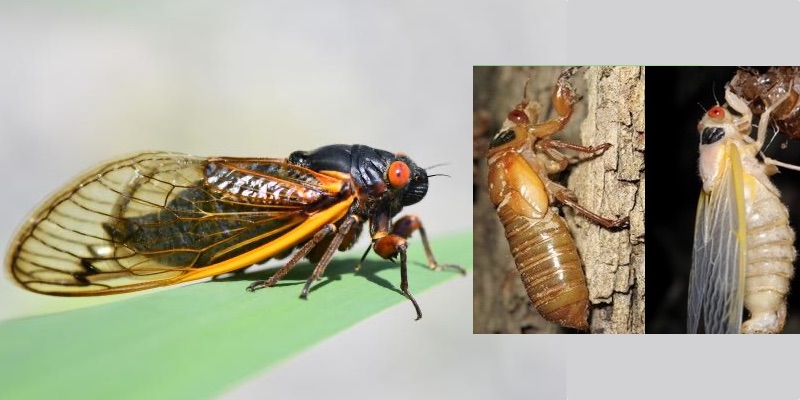
Brood XIX has a 13-year cycle. It is interesting because it features both Magicicada neotredecim and Magicicada tredecim. These cicadas are very similar in song and appearance, but in areas where they overlap, Magicicada neotredecim alters its song to a higher pitch, which allows female cicadas to determine the species of their prospective mates. Visit Cicadas @ UCONN for more info on this behavior.
M. tredecim also have more orange on their abdomen than M. neotredecim.
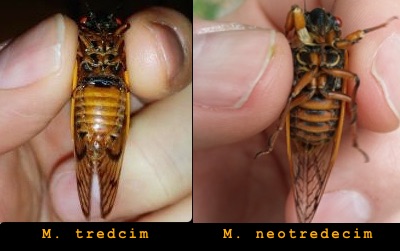
When: Typically beginning in mid-May and ending in late June. These cicadas will begin to emerge approximately when the soil 8 inches beneath the ground reaches 64 degrees Fahrenheit. A nice, warm rain will often trigger an emergence.
Other tips: these cicadas will emerge after the trees have grown leaves, and, by my own observation, around the same time Iris flowers bloom.
Where:
View the live maps on iNaturalist.
More Location Tips:
Why: Why do they stay underground for 13 years? The prevailing research suggests they’ve evolved a long, 13-year lifecycle allowing them to avoid predators that would sync up with their lifecycle & emergence. Why are there so many?! Research suggests that their huge numbers allow them to overwhelm predators, so enough of them will live on to breed and perpetuate the brood.
More facts and fun:
See a modern map or the Live Map from the Cicada Safari app.
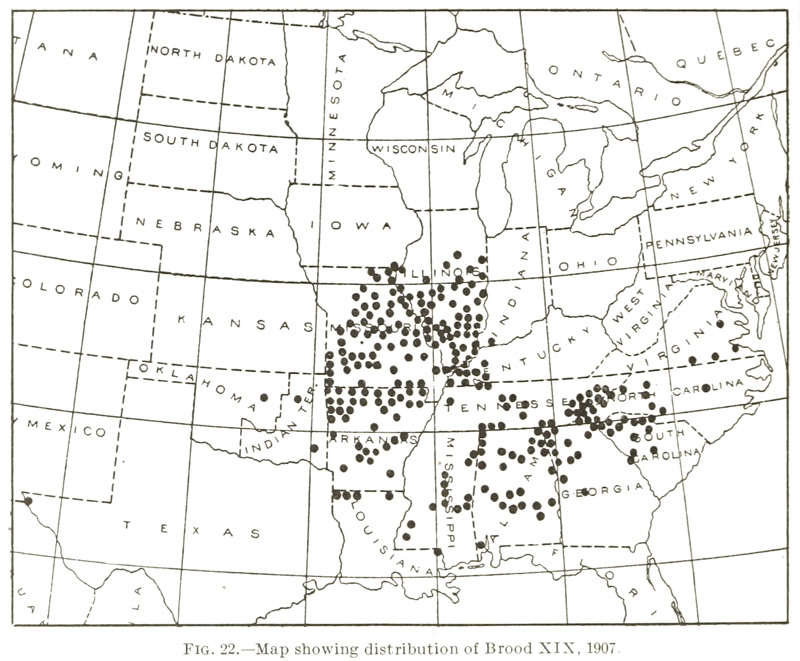
What happened in 2011? Here’s some old blog posts with comments:
What happened in 1998? Here’s our message board from then:
These are the 17 most interesting 17-year cicada facts (IMHO). All these facts apply to 13-year cicadas as well.
People call these cicadas “locusts” but they are not true locusts — real locusts look like grasshoppers. The phrase “17-year cicada” indicates that they arrive every 17 years. The name “periodical cicadas” indicates that they arrive periodically and not each and every year. The scientific name for the Genus of these cicadas is Magicicada, and there are 3 types of 17 year Magicicadas: Magicicada septendecim, Magicicada cassini and Magicicada septendecula.
This is a true locust:
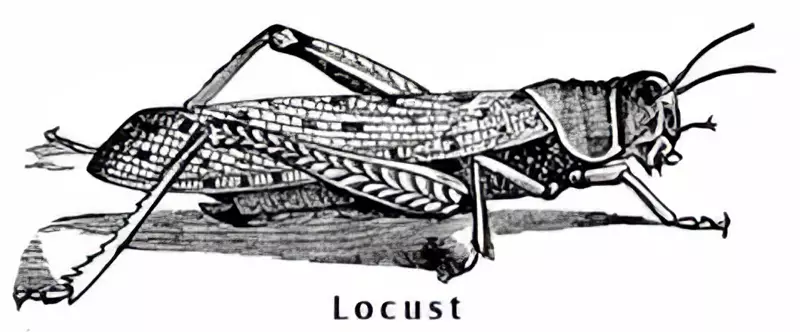
There are 13-year cicadas too! There are four species of 13-year cicadas: Magicicada tredecim, Magicicada neotredecim, Magicicada tredecassini, and Magicicada tredecula. Broods XIX, XXII and XXIII feature these cicadas.
Here’s a video that will help you identify the various species.
Most 17-Year Cicadas have red eyes, but they can also have white, gray, blue , or multi-colored eyes.
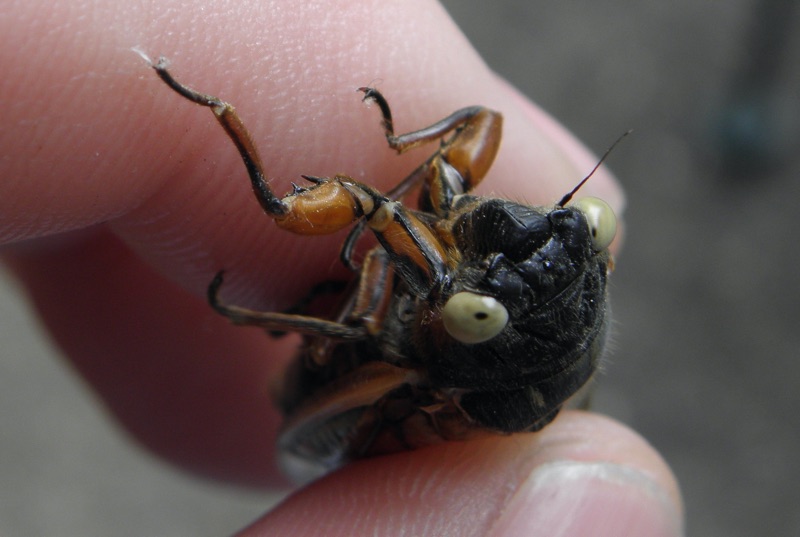
The Massospora cicadina fungus infects Magicicadas, destroying their abdomen and ability to reproduce. Often, their entire abdomen will fall off. The cicadas spread the fungus throughout their local colony via mating. The Massospora fungus is a cicada STD!
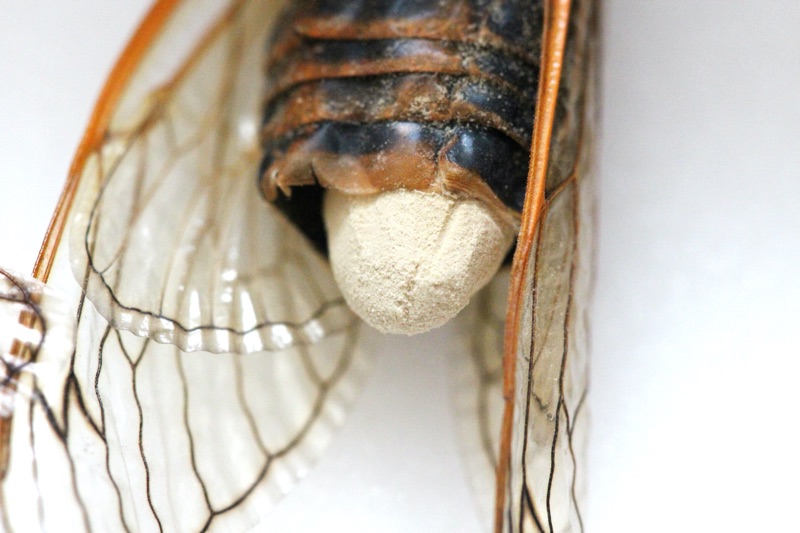
Cicadas think the sounds made by power tools and lawn maintenance equipment are made by cicadas. They get confused and will land on the people using the equipment! Pro-tip: cut your lawn in the early morning or near dusk when the cicadas are less active.

Cicadas have two, obvious, large, compound eyes, and three ocelli. Ocelli are three jewel-like eyes situated between the two main, compound eyes of a cicada. We believe ocelli are used to detect light and darkness. Ocelli means little eyes in Latin.
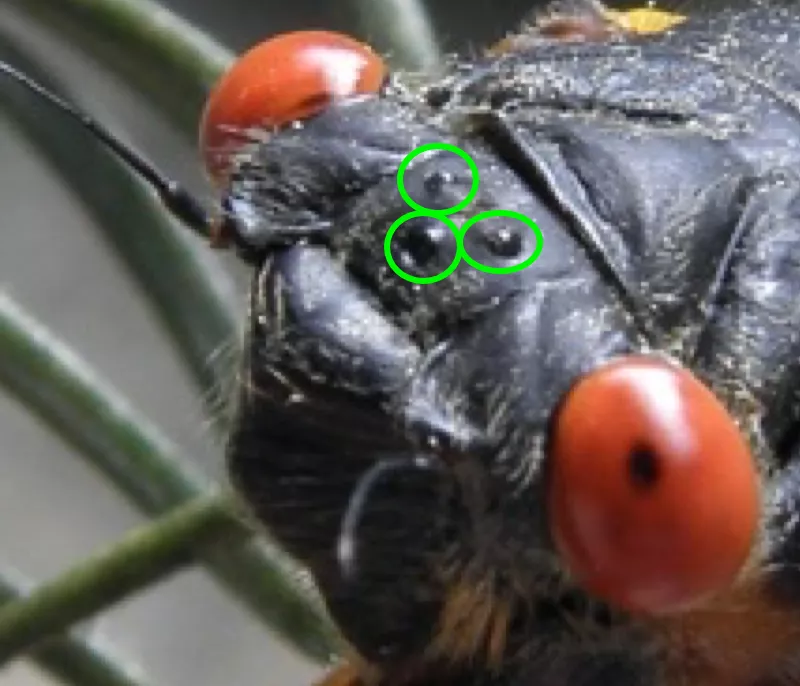
People eat them. You can barbecue it, boil it, broil it, bake it, sauté it. There, uh, cicada kabobs, cicada creole, cicada gumbo, panfried, deep fried, stir fried. There’s pineapple cicada, lemon cicada, coconut cicada, pepper cicada, cicada soup, cicada stew, cicada salad, cicada and potatoes, cicada burger, cicada pizza, cicada sandwich… that’s, that’s about it.

All wild animals and domestic pets will eat them. Dogs will gorge themselves until they choke. Squirrels will eat them like corn on the cob. Wild turkeys will grow fat and juicy on the cicada feast. Fish go crazy for them too — you can use them as bait, or use lures that mimic them.
Cicadas don’t eat solid foods like leaves or fruits. Instead they use their slender, straw-like mouth parts to drink tree fluids.
Yes cicadas pee, so wear a hat when walking under trees if that sort of thing bothers you. Cicadas drink tree fluids and then expel the excess fluid they do now need. People call it “honeydew” or “cicada rain”.
Only male cicadas make the loud sound they are famous for. Males have organs on their abdomen called tymbals. Muscles pop the tymbals in and out, which creates the sound we hear. Males make different calls for different reasons, and each species has a unique sound. Females can make sound too: they flick their wings to respond to males.
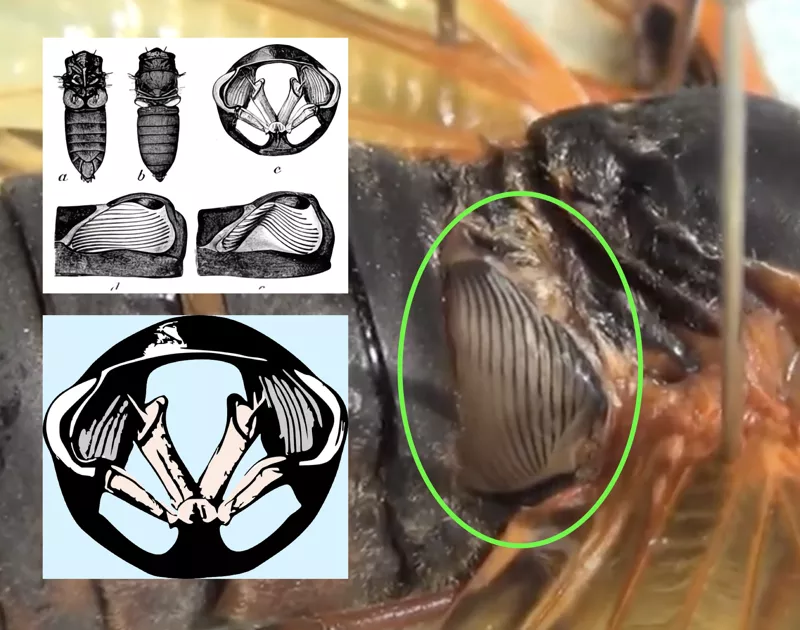
There are literally billions, if not trillions, of 17-year cicadas. Why? One theory suggests that a large number of cicadas overwhelms predators, so predators are never able to eat them all and cicadas, and many always survive to mate. This is a survival strategy called “predator satiation”.
The biggest concern about 17-year cicadas is their potential to damage young trees. The truth is they will damage limbs on the wimpiest of trees, so if you have weak, pathetic, wimpy ornamental trees in your yard you should consider placing netting around the trees if the cicadas visit your yard. Also, you can try hosing them off with water, placing insect barrier tape around the trunk of the trees, or picking them off like grapes! Or, plant strong, beefy American trees — that’s what I would do. Cicadas actually benefit the health of trees by aerating the soil around the roots and trimming the weak or damaged limbs.
Periodical cicadas that emerge in years before they are supposed to emerge are called stragglers.
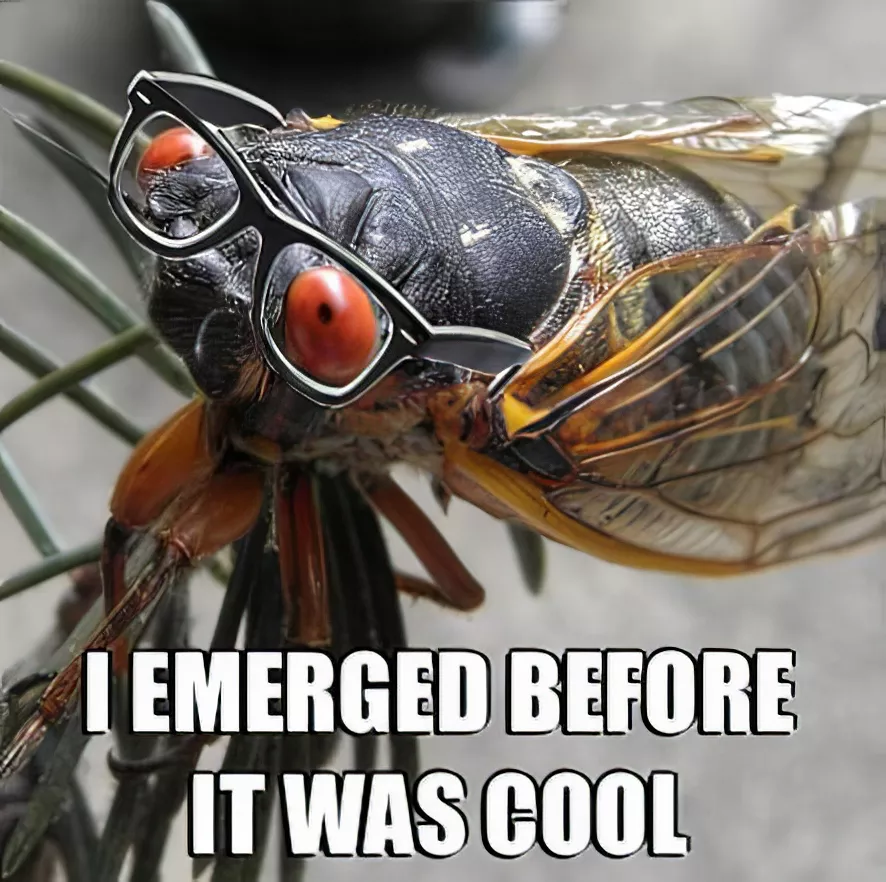
Scientist speculate that one reason why these cicadas emerge in 17 or 13 year cycles is because those are prime numbers. The fact that 13 & 17 are relatively large* prime numbers makes it difficult for predators to synchronize with them. (*Relative to the average lifespan of an animal.) Annual cicadas (cicadas that arrive every year) often have wasps specialized to prey on them; periodical cicadas have no such wasp because no wasp could evolve to synch with it.
Cicadas need to be warm to sing and fly around. Their dark skin absorbs the heat of the sun, which helps to warm them up.
Cicada Broods usually don’t overlap geographically, and it is very rare when they emerge in the same year. In 2024, Brood XIX and Brood XIII are both emerging.
###
If you have 18 minutes to spare, watch the video version of this article.